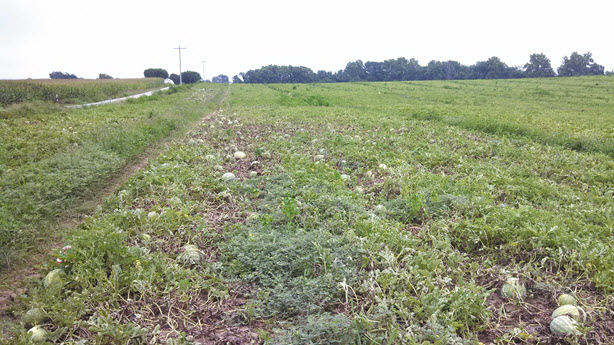Protecting vegetable crops from foliar disease involves many factors. Crop rotation and fall tillage will help to lessen disease severity. Choosing a resistant or partially resistant variety can lower the amount of disease. Purchasing seed that has been tested for seed borne disease is also an important factor. Most growers, however, find it is also necessary to apply fungicides to manage foliar diseases. This article will discuss when such applications are productive-and one case where they may not be.
Foliar fungicides are most effective when applied before infection of a plant disease takes place or early in the disease epidemic. That is, it is best to apply fungicides before one observes disease and at regular intervals. Fungicides are designed to protect healthy foliage from disease. Applications of fungicides will not change plant tissue that has been turned brown (necrotic) from disease into green healthy tissue.
Figure 1 shows a watermelon field with severe symptoms of anthracnose. Large areas of the field appear brown due to anthracnose infection. This situation may have resulted from missed fungicide applications, lack of crop rotation or weather conditions very conducive to disease. In any case, the common reaction of a grower upon viewing such a field is to apply a fungicide. Many times the reaction is to reach for an expensive cure. Again, no fungicide will turn brown plants into green plants.
When the decision to apply fungicides to a vegetable field with severe foliar symptoms is made, the grower should make such an application with the aim of protecting healthy plants. Is there a large enough area of healthy plants to justify a fungicide application?
It may be argued that some systemic fungicides have what may be referred to as ‘kickback action’. That is, the fungicide is designed to move in the plant and stop fungi inside diseased tissue. Won’t such a fungicide bring plants back from a diseased situation?
The successful application of many systemic fungicides with ‘kickback action’ will stop or slow fungi inside plant tissue. One should think about such action as inhibiting fungi at the edge of a plant lesion before it can expand into healthy tissue. Even if fungi are stopped inside necrotic tissue, the tissue will remain brown. Thus, fungicides should be applied to protect green tissue from disease.
When applications of fungicides are made to fields such as in Figure 1, one should also remember that the disease has almost certainly spread beyond the dead plants. Since it takes 7 to 10 days for diseased plants to show symptoms, more of the plants are diseased than what are observed in Figure 1.
An argument can be made that some crops may be able to regrow healthy leaves, branches and fruit from diseased plants if kept healthy with fungicides. The decision to apply fungicides to allow regrowth of healthy plant tissue will depend of the cost and efficacy of the fungicide(s), the weather (dry weather will be more likely to favor healthy growth), market value of the produce and stage of crop.
Applications of a fungicide to non-productive plants may be made as a way to reduce disease inoculum that may otherwise spread to healthy plants. If one is realistic about why such a fungicide is applied, then this type of application can be justified if the cost is right. Another management tool is to remove or rogue diseased plants to stop disease spread. But this is a topic for another time.
My intent is not to be pessimistic about vegetable production or fungicide use. Instead, I would like to point out the importance of timely use of fungicides, especially early in the season. In contrast, fungicides applied late in the season to a crop already very much affected by foliar disease may not be useful. Vegetable growers should be realistic about applications of fungicides to late season crops with significant amounts of disease.
